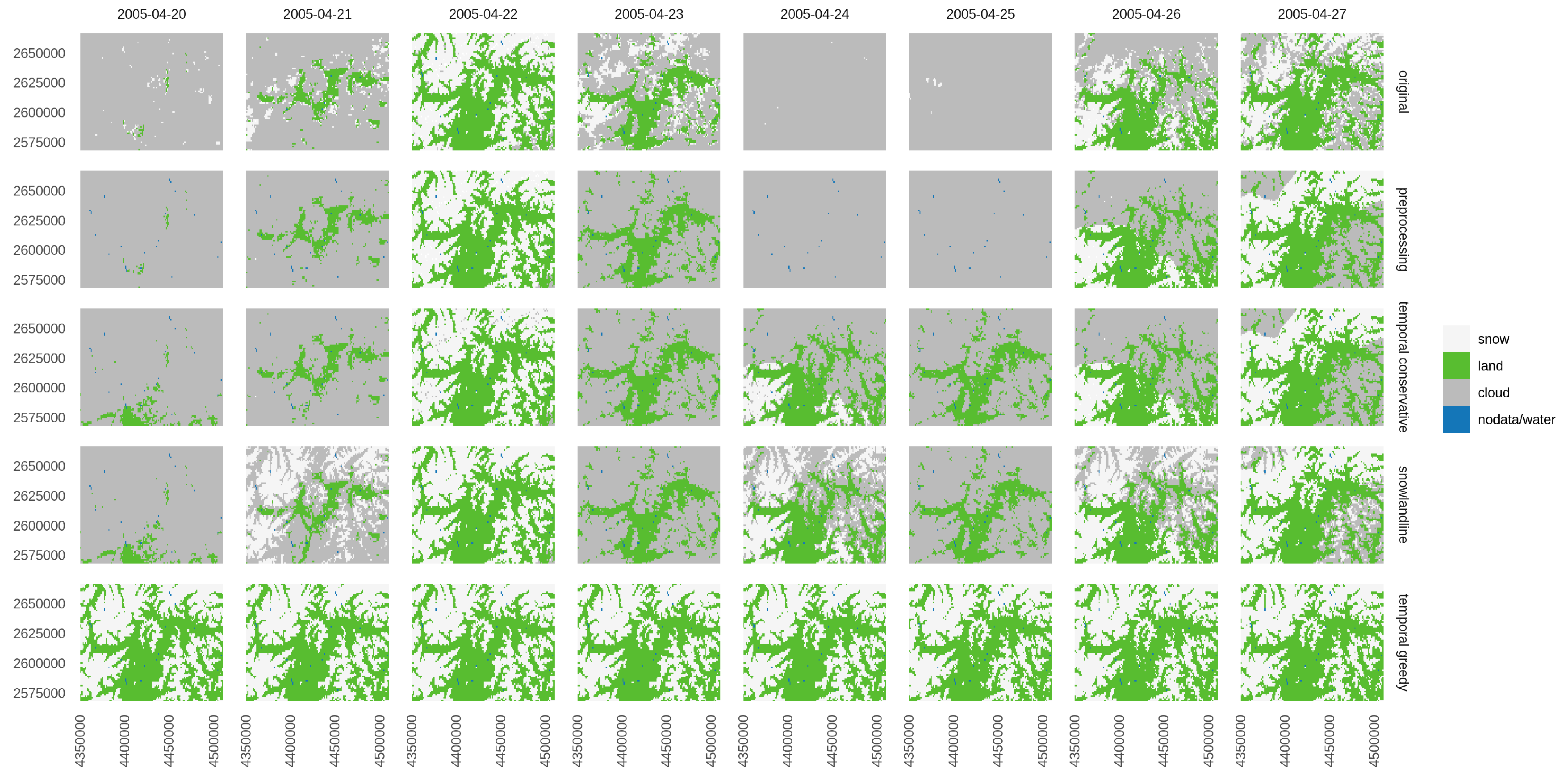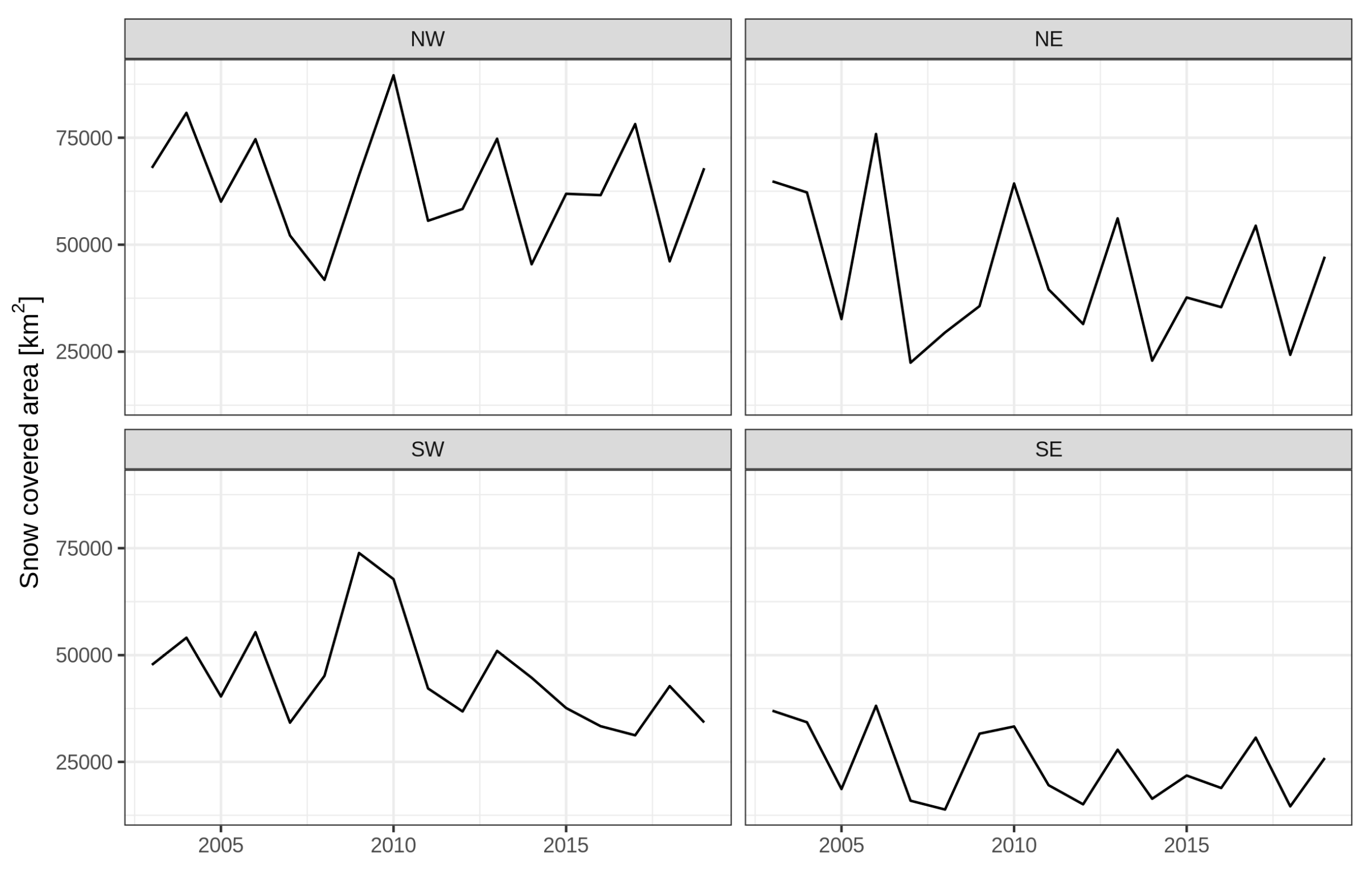Daily MODIS Snow Cover Maps for the European Alps from 2002 onwards at 250 m Horizontal Resolution Along with a Nearly Cloud-Free Version
Abstract
:1. Summary
2. Data Description
3. Methods
3.1. EURAC_SNOW
3.1.1. Summary of Algorithm Published in 2013
3.1.2. Post-2013 Changes
3.2. EURAC_SNOW_CLOUDREMOVAL
3.2.1. Proposed Filter Sequence for Cloud Removal
3.2.2. Caveats of Filtering Sequence and Alternatives
3.3. Validation
3.3.1. Summary of Initial EURAC_SNOW Validation from 2013
3.3.2. New, Extended Validation of EURAC_SNOW and EURAC_SNOW_CLOUDREMOVAL with Station Data
3.3.3. Spatial Cross Validation of EURAC_SNOW_CLOUDREMOVAL
4. User Notes
4.1. Data Access
4.2. Example Usage
4.3. Other Cautionary Notes
Supplementary Materials
Author Contributions
Funding
Acknowledgments
Conflicts of Interest
References
- Notarnicola, C.; Duguay, M.; Moelg, N.; Schellenberger, T.; Tetzlaff, A.; Monsorno, R.; Costa, A.; Steurer, C.; Zebisch, M. Snow Cover Maps from MODIS Images at 250 m Resolution, Part 1: Algorithm Description. Remote Sens. 2013, 5, 110–126. [Google Scholar] [CrossRef] [Green Version]
- Asam, S.; Callegari, M.; Matiu, M.; Fiore, G.; De Gregorio, L.; Jacob, A.; Menzel, A.; Zebisch, M.; Notarnicola, C. Relationship between Spatiotemporal Variations of Climate, Snow Cover and Plant Phenology over the Alps—An Earth Observation-Based Analysis. Remote Sens. 2018, 10, 1757. [Google Scholar] [CrossRef] [Green Version]
- De Gregorio, L.; Callegari, M.; Marin, C.; Zebisch, M.; Bruzzone, L.; Demir, B.; Strasser, U.; Marke, T.; Günther, D.; Nadalet, R.; et al. A Novel Data Fusion Technique for Snow Cover Retrieval. IEEE J. Sel. Top. Appl. Earth Obs. Remote Sens. 2019, 12, 2862–2877. [Google Scholar] [CrossRef] [Green Version]
- De Gregorio, L.; Callegari, M.; Mazzoli, P.; Bagli, S.; Broccoli, D.; Pistocchi, A.; Notarnicola, C. Operational River Discharge Forecasting with Support Vector Regression Technique Applied to Alpine Catchments: Results, Advantages, Limits and Lesson Learned. Water Resour. Manag. 2018, 32, 229–242. [Google Scholar] [CrossRef]
- Engel, M.; Notarnicola, C.; Endrizzi, S.; Bertoldi, G. Snow model sensitivity analysis to understand spatial and temporal snow dynamics in a high-elevation catchment. Hydrol. Process. 2017, 31, 4151–4168. [Google Scholar] [CrossRef]
- Pimentel, R.; Marín, C.; Gregorio, L.D.; Callegari, M.; Pérez-Palazón, M.J.; Notarnicola, C.; Polo, M.J. Validating improved-MODIS products from spectral mixture-Landsat snow cover maps in a mountain region in southern Spain. Proc. Int. Assoc. Hydrol. Sci. 2018, 380, 67–72. [Google Scholar] [CrossRef]
- Pistocchi, A.; Bagli, S.; Callegari, M.; Notarnicola, C.; Mazzoli, P. On the Direct Calculation of Snow Water Balances Using Snow Cover Information. Water 2017, 9, 848. [Google Scholar] [CrossRef] [Green Version]
- Xie, J.; Kneubühler, M.; Garonna, I.; Notarnicola, C.; Gregorio, L.D.; Jong, R.D.; Chimani, B.; Schaepman, M.E. Altitude-dependent influence of snow cover on alpine land surface phenology. J. Geophys. Res. Biogeosci. 2017, 122, 1107–1122. [Google Scholar] [CrossRef] [Green Version]
- Xie, J.; Kneubühler, M.; Garonna, I.; de Jong, R.; Notarnicola, C.; Gregorio, L.D.; Schaepman, M.E. Relative Influence of Timing and Accumulation of Snow on Alpine Land Surface Phenology. J. Geophys. Res. Biogeosci. 2018, 123, 561–576. [Google Scholar] [CrossRef]
- Matiu, M.; Jacob, A.; Notarnicola, C. Daily MODIS snow cover maps for the European Alps from 2002 onwards at 250 m horizontal resolution along with a nearly cloud-free version. Dataset Zenodo 2019. [Google Scholar] [CrossRef]
- Dozier, J.; Painter, T.H.; Rittger, K.; Frew, J.E. Time–space continuity of daily maps of fractional snow cover and albedo from MODIS. Adv. Water Resour. 2008, 31, 1515–1526. [Google Scholar] [CrossRef]
- Parajka, J.; Blöschl, G. Spatio-temporal combination of MODIS images – potential for snow cover mapping. Water Resour. Res. 2008, 44. [Google Scholar] [CrossRef]
- Parajka, J.; Pepe, M.; Rampini, A.; Rossi, S.; Blöschl, G. A regional snow-line method for estimating snow cover from MODIS during cloud cover. J. Hydrol. 2010, 381, 203–212. [Google Scholar] [CrossRef]
- Da Ronco, P.; De Michele, C. Cloud obstruction and snow cover in Alpine areas from MODIS products. Hydrol. Earth Syst. Sci. 2014, 18, 4579–4600. [Google Scholar] [CrossRef] [Green Version]
- Dong, C.; Menzel, L. Producing cloud-free MODIS snow cover products with conditional probability interpolation and meteorological data. Remote Sens. Environ. 2016, 186, 439–451. [Google Scholar] [CrossRef]
- Tran, H.; Nguyen, P.; Ombadi, M.; Hsu, K.; Sorooshian, S.; Qing, X. A cloud-free MODIS snow cover dataset for the contiguous United States from 2000 to 2017. Sci. Data 2019, 6, 180300. [Google Scholar] [CrossRef] [PubMed]
- Hall, D.K.; Riggs, G.A.; DiGirolamo, N.E.; Román, M.O. MODIS Cloud-Gap Filled Snow-Cover Products: Advantages and Uncertainties. Hydrol. Earth Syst. Sci. Discuss. 2019. [Google Scholar] [CrossRef] [Green Version]
- Hall, D.K.; Riggs, G.A.; Foster, J.L.; Kumar, S.V. Development and evaluation of a cloud-gap-filled MODIS daily snow-cover product. Remote Sens. Environ. 2010, 114, 496–503. [Google Scholar] [CrossRef] [Green Version]
- Notarnicola, C.; Duguay, M.; Moelg, N.; Schellenberger, T.; Tetzlaff, A.; Monsorno, R.; Costa, A.; Steurer, C.; Zebisch, M. Snow Cover Maps from MODIS Images at 250 m Resolution, Part 2: Validation. Remote Sens. 2013, 5, 1568–1587. [Google Scholar] [CrossRef] [Green Version]
- Hantel, M.; Ehrendorfer, M.; Haslinger, A. Climate sensitivity of snow cover duration in Austria. Int. J. Climatol. 2000, 20, 615–640. [Google Scholar] [CrossRef]
- Gafurov, A.; Bárdossy, A. Cloud removal methodology from MODIS snow cover product. Hydrol. Earth Syst. Sci. 2009, 13, 1361–1373. [Google Scholar] [CrossRef] [Green Version]
- Paudel, K.P.; Andersen, P. Monitoring snow cover variability in an agropastoral area in the Trans Himalayan region of Nepal using MODIS data with improved cloud removal methodology. Remote Sens. Environ. 2011, 115, 1234–1246. [Google Scholar] [CrossRef]



| Characteristic | EURAC_SNOW | EURAC_SNOW_CLOUDREMOVAL |
|---|---|---|
| Name (coverage) | EURAC_SNOW_MODIS_ALPS_LAEA | EURAC_SNOW_CLOUDREMOVAL_MODIS_ ALPS_LAEA |
| Bands | SnowMap, SnowQuality 1 | SnowMap |
| Data type (SnowMap) | Integer (0 = no data; 1 = snow; 2 = land; 3 = cloud; 4 and 5 = water bodies) | Integer (0 = no data; 1 = snow; 2 = land; 3 = cloud; 5 = water bodies/no data) |
| Data format | TIFF 2 | same |
| Projection (proj4 string) | Lambert azimuthal equal-area (+init = epsg:3035 + proj = laea + lat_0 = 52 + lon_0 = 10 + x_0 = 4321000 + y_0 = 3210000 + ellps = GRS80 + towgs84 = 0,0,0,0,0,0,0 + units = m + no_defs) | same |
| Spatial coverage | xmin–xmax: 3847098–4982446 ymin–ymax: 2208289–2872448 (longlat~4.2–19.0 E, 43.0–48.6 N) | same |
| Spatial resolution | nominal: 250 m actual in projection: 232 m | same |
| Temporal coverage | 3 July 2002–09 June 2019 (as of 30 September 2019; updated automatically) | 3 July 2002–31 May 2019 |
| Temporal resolution | daily | same |
| Access | Platform | Package/Module Name | URL |
|---|---|---|---|
| WCPS 1 | online | http://saocompute.eurac.edu/rasdaman/ows | |
| R | CubeR | https://gitlab.inf.unibz.it/earth_observation_public/CubeR | |
| python | modis_snow_cloudremoval | https://gitlab.inf.unibz.it/earth_observation_public/modis_snow_cloud_removal | |
| openEO 2 | online | http://editor.openeo.org/ | |
| R | openeo-r-client | https://github.com/Open-EO/openeo-r-client | |
| python | openeo-python-client | https://github.com/Open-EO/openeo-python-client |
| Cloud Removal Step | Mean Overall Accuracy | Mean Cloud Fraction | Station Data Used |
|---|---|---|---|
| Original 1 | 93.0% | 41.9% | 45.6% |
| Preprocessing | 94.0% | 40.0% | 45.0% |
| Temporal conservative | 94.6% | 25.4% | 60.6% |
| Snowlandline | 94.4% | 22.0% | 63.7% |
| Temporal greedy max10d 2 | 91.5% | 0.1% | 99.4% |
© 2019 by the authors. Licensee MDPI, Basel, Switzerland. This article is an open access article distributed under the terms and conditions of the Creative Commons Attribution (CC BY) license (http://creativecommons.org/licenses/by/4.0/).
Share and Cite
Matiu, M.; Jacob, A.; Notarnicola, C. Daily MODIS Snow Cover Maps for the European Alps from 2002 onwards at 250 m Horizontal Resolution Along with a Nearly Cloud-Free Version. Data 2020, 5, 1. https://doi.org/10.3390/data5010001
Matiu M, Jacob A, Notarnicola C. Daily MODIS Snow Cover Maps for the European Alps from 2002 onwards at 250 m Horizontal Resolution Along with a Nearly Cloud-Free Version. Data. 2020; 5(1):1. https://doi.org/10.3390/data5010001
Chicago/Turabian StyleMatiu, Michael, Alexander Jacob, and Claudia Notarnicola. 2020. "Daily MODIS Snow Cover Maps for the European Alps from 2002 onwards at 250 m Horizontal Resolution Along with a Nearly Cloud-Free Version" Data 5, no. 1: 1. https://doi.org/10.3390/data5010001







